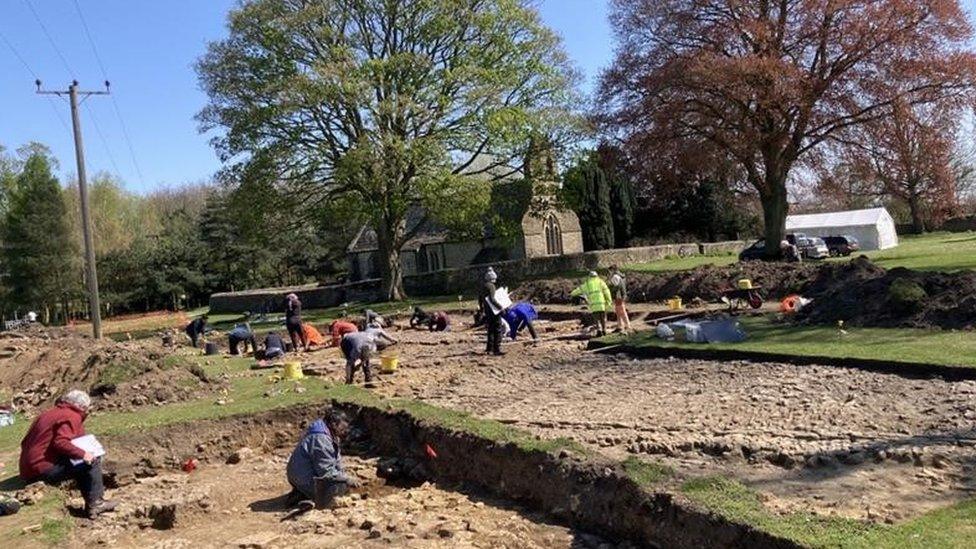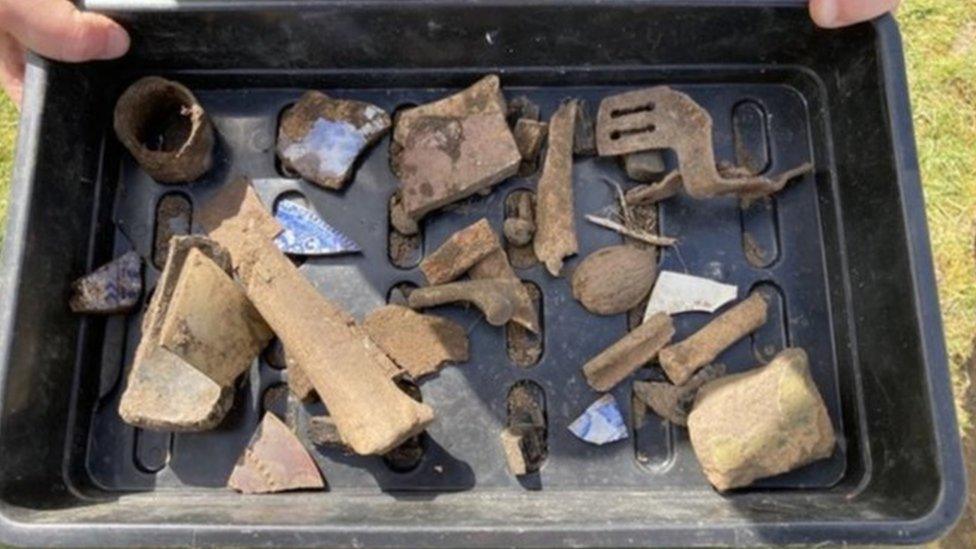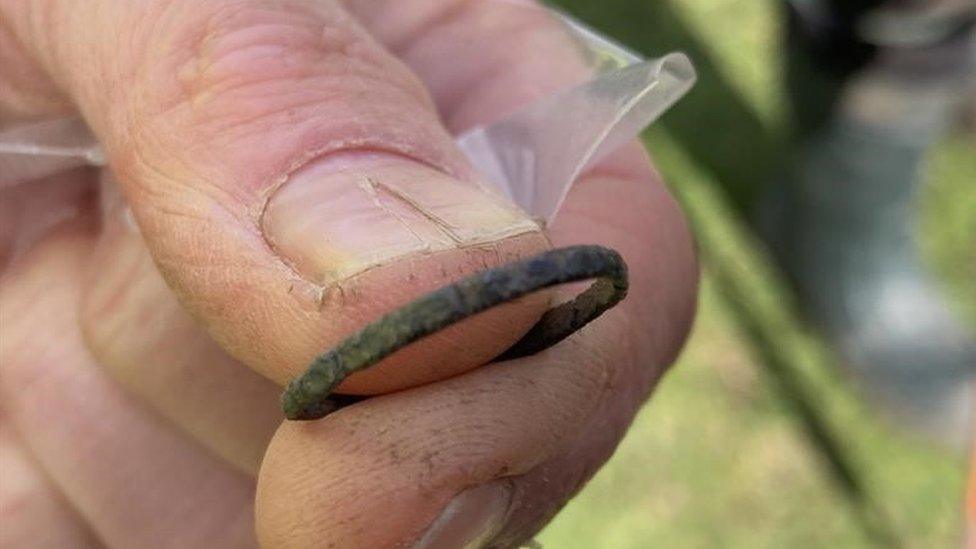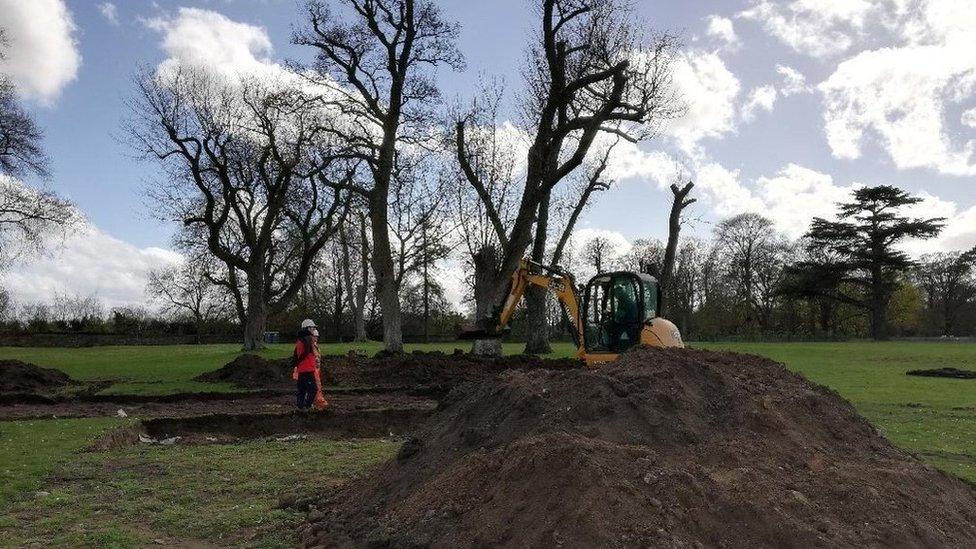Besselsleigh excavations reveal colourful history of lost manor
- Published

The area has been through changes across three historical periods; the Roman, the Anglo-Saxon, and the English Civil War
Archaeologist Dr Jane Harrison and her team of experts, students, and volunteers have been peeling away layers of history at the site of what used to be a manor house.
I arrived on the first day of their excavations to find out what treasures they were unearthing.
I'm on a plot of land south of Besselsleigh village in Oxfordshire that is being uncovered by archaeological experts for the first time.
We're surrounded by piles of soil, and giant sieves are used to filter out the dust in case something of interest is hiding within.
Some of the team members I'm with record the site with drawings, a metal detectorist scans for further findings, and a big excavator rests nearby.
All the while keen volunteers in trenches armed with various tools strip away the further layers beneath.
Dr Harrison's team have discovered the manor house and surrounding area have been through changes across three historical periods; the Roman, the Anglo-Saxon, and the English Civil War.

Dr Jane Harrison's team have spent a total of four weeks on the excavations
"This year we are hoping to find out more about the Anglo-Saxon origins of the manor and uncover more of the layout of the central manor buildings", Dr Harrison tells me, while showing me around.
"We hope this will help us get to grips with the changes made in the medieval period as different branches of the family took charge, and then the rebuilding before the English Civil War.
"We think this is when the villagers were thrown off the estate.
"Finally, we want to understand more about the fate of the manor during the Civil War attacks.
"And finding pre-Conquest archaeology means an exciting link with the Roman roadside settlement immediately to the north."
Previous discoveries of "intriguing" Anglo-Saxon artefacts showed the manor house pre-dates the Norman conquest.
Other finds include the signs of a metre-wide medieval wall underneath 17th Century cobbles, indicating a large rebuilding scheme just before the Civil War.

Volunteers in trenches armed with various tools strip away the layers of history
"We also have a lead pipe - part of a medieval domestic fresh water system - that was ripped up and cut off in the 17th Century," Dr Harrison says.
"We found the twisted remains of the junctions. This plumbing system is very surprising because it's very early and very sophisticated and it's a dead ringer for a Roman system."
There is also plenty of bone, oyster shell, buttons, and "a sweet collection of 19th Century children's lead toys" including a little cannon and two soldiers.
"The speaker of the Parliament William Lenthall took down what would have been an old-fashioned building for him that didn't quite express his ambitions", Dr Harrison says.
"He took down the back part of the medieval manor, covered it over, and his 17th Century manor was constructed across the front looking towards a drive with a pillared entrance.
"So it was much more gracious, looking more like a very mini-Blenheim Palace in style."

The dig has unearthed an array of findings from over the centuries

The mystery items will be stored and further analysed by experts
While the two of us talk, volunteers come over brandishing their findings, with one man bringing around piece of pottery.
"It barely has any curvature at all, has it?" Dr Harrison exclaims as she examines the piece.
"That's high medieval, so it belongs to the 15th, or maybe early 16th Century. But that's one heck of a pot."
Now they're speculating what it was used for.
"Putting a big heap of something in it. Soup? Terrine? Goodness knows." Dr Harrison ponders. "Hot tub?"
They deduce it was enormous and probably a storage jar that wasn't moved once it was filled.
This, along with other similar pieces will be analysed by pottery experts.

Archaeologist Dr Jane Harrison is leading a team of experts, students, and volunteers at the dig site
"I found out about the site through word of mouth," says Oscar, an archaeology student.
"This is the first time I've been working on a medieval manor. It's definitely something I'd like to know more about.
"I'd like to get deeper into the Roman levels but the English Civil War is still something that is so important today."
Sarah Miles, who is part of the supervisory team which helps teach the students and the volunteers, says: "It's really nice having local volunteers on site because they're connecting with their history.
"This is where they live and it's giving them a connection with the local heritage.
"This beautiful area of cobbles took the volunteers a whole week to uncover and it's really exciting."

An excavator rests next to large piles of soil which will be sieved later
I spend a few hours digging in the central trench myself, eagerly looking for a rare find.
The result? I've dug a little bit deeper than I should have.
"Archaeology is not treasure hunting", Sarah explains. "You're unravelling a story, not looking for stuff. You're looking for information.
"And if you just dig a deep hole to find something in it, you lose all the information around it, so that's why we take back the layers very thoughtfully."
I follow her advice and, about an hour later, she comes back to check on my work. This time I've done a better job.
Sarah assures me such mistakes are very common in first-time diggers.
"Don't worry, you're not special... You also dig with Doc Martens - very classy."

Follow BBC South on Facebook, external, Twitter, external, or Instagram, external. Send your story ideas to south.newsonline@bbc.co.uk, external
Related topics
- Published29 April 2023

- Published6 March 2023
